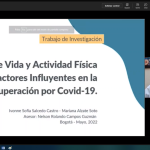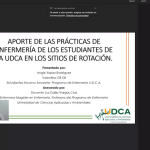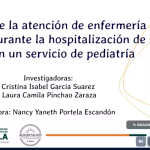Semillero
Cuidado de la Vida y la Salud
Cuidado de la Vida y la Salud
Crear estrategias que convoquen y permitan el encuentro de estudiantes para desarrollar competencias en diferentes áreas y campos del saber.
Misión
Fortalecer los procesos académicos que motivan y guían la Investigación de estudiantes y profesores para generar nuevos conocimientos para el avance de la ciencia y la tecnología en el país.
Visión
El semillero de investigación será reconocido por su compromiso en la formación de nuevos investigadores y el desarrollo de investigación en red.
Objetivos específicos:
- Desarrollar competencias comunicativas, investigativas y laborales.
- Facilitar el intercambio de experiencias investigativas entre los semilleros de investigación.
Áreas de Investigación
- Cuidado de la salud en el ciclo vital humano.
- Formación y ejercicio de recurso humano.
- Salud ambiental y soberanía alimentaria.
- Convivencia social y salud mental.
- Salud y ámbito laboral.
- Sexualidad y derechos sexuales y reproductivos.
- Medicamentos.

COORDINADORES
PRODUCTOS DESTACADOS
Cap. V Teoría Fundamentada: Ruta metodológica para la construcción epistémica de ambientes comunicativos de aprendizaje
En los sistemas educativos contemporáneos, y más allá de los modelos que los definen y le dan sentido práctico al acto pedagógico, ha sido la transformación de la información en conocimiento un reto para el diseño de los ambientes de aprendizaje escolares. En la actualidad, los contenidos disciplinares inmersos en modelos transmisionistas, han incrementado la distancia dialógica entre profesores y estudiantes y se han constituido en un campo propicio para el exceso de información, la desinformación, la entropía, los ruidos, los problemas de malinterpretación, entre otros obstáculos de carácter comunicativo que finalmente se constituyen en limitaciones cognitivas para la construcción y adquisición del conocimiento en el aula de clases.
La formación continua del profesorado y la investigación educativa posgradual
La rapidez con la que se producen actualmente en el contexto Latinoamericano, los continuos cambios económicos, políticos, sociales, culturales, científicos y tecnológicos, ha causado notables efectos en el ámbito de la educación superior, entre los que se destaca significativamente, las tensiones entre la concepción tradicional y los nuevos formas relativas a la formación pos gradual y la producción de conocimiento, igualmente, el ritmo la dinámica de transformación impone de manera sobresaliente, nuevas formas de pensar y actuar sobre la realidad educativa.
Mood rhythmicity is associated with depressive symptoms and caffeinated drinks consumption in South American young adults
Among the factors that contribute to the onset and maintenance of depressive disorders, rhythmicity of symptoms and consumption of caffeine have recently gained attention. The current study aimed to examine the differential rhythmicity of relevant variables in a sample of young participants, considering the presence of depressive symptomatology and the frequency of caffeinated drinks consumption. A significant 24-hour differential rhythmicity of mood, cognitive and physiological variables was found indicating an evening peak pattern in the participants with depressive symptoms. Interestingly, caffeinated drinks consumption was differentially associated with self-perceived peaks, according to the presence of depressive symptomatology. Our findings are among the first reports about the potential association of the 24-hours rhythmicity of relevant mood-related variables, depressive symptoms, and caffeine intake. These results support the view that the identification of risk factors for depression, and the application of novel measurements and analysis methods in the development of new preventive strategies should be a public health priority
Anxiety symptomatology, sex and chronotype: The mediational effect of diurnal sleepiness
Diurnal subjective sleepiness has been associated with a large number of negative outcomes, such as increased risk of accidents and development of mental disorders as depression and anxiety. However, the role of the diurnal subjective sleepiness as a mediator is poorly understood. The goal of the present study was to examine the role of diurnal subjective sleepiness as a mediator of the relationship between sex, chronotype and anxiety symptoms in healthy young adults. Four-hundred and sixty-seven healthy young adults (64.8% females, age range 18–32 years, mean 20.7, ±2.3) were evaluated with validated and widely used scales for the measurement of diurnal sleepiness, anxiety symptoms and morningness–eveningness preference. We have found that diurnal subjective sleepiness correlated with anxiety symptoms when evaluated both in the total sample and within chronotypes. This association was more important in females than in males (p < 0.0001). Regarding chronotype, only for morning-types, diurnal subjective sleepiness was a significant mediator of the relationship between sex and anxiety symptoms. This is the first study that examines the mediator role of diurnal subjective sleepiness in the known relationship between sex and anxiety symptoms, and adds new evidence about the effect of the chronotype on sleep problems and mental health. Although future work is required, our results have important implications for clinical settings and public health interventions
Substance use and suicide risk in a sample of young Colombian adults: An exploration of psychosocial factors
Background and Objectives: Young adults might engage in many risk behaviors, including alcohol and drug use, which could lead to mental health problems, such as suicide. The aim of this study was to examine specific psychosocial and clinical factors that could influence the possible relationship between polysubstance use (PSU) and suicide risk in a sample of young Colombian participants. Methods: A sample of 274 young participants (mean age = 21.3 years) was evaluated with two substance use screening tests (ASSIST and AUDIT) and five scales for clinical and psychosocial factors and suicide risk: The Center for Epidemiologic Studies Depression scale, Zung Self-Rating Anxiety scale, Family APGAR, the Childhood Trauma Questionnaire, and the Plutchik Suicide Risk scale. Correlation and multiple regression analyses were conducted. Results: Use of cannabis and tobacco was significantly correlated with suicide risk in the total sample (p <.05). Depressive and anxiety symptoms, family functioning, and emotional abuse during childhood were significantly associated with suicide risk (p <.001), while alcohol use, anxiety symptoms, and family functioning were variables significantly related to PSU. Discussion and Conclusions: Our findings are consistent with previous evidence suggesting a relationship between substance use, several psychosocial factors, and suicide risk in young participants. Scientific Significance: Our study is one of the first reports the relationship between substance use and suicide risk in a Latin American population. (Am J Addict 2017;26:388–394)




















